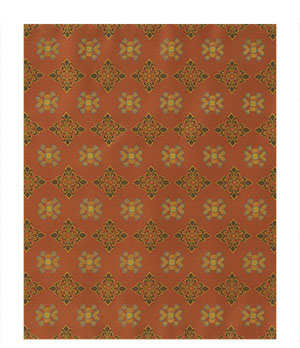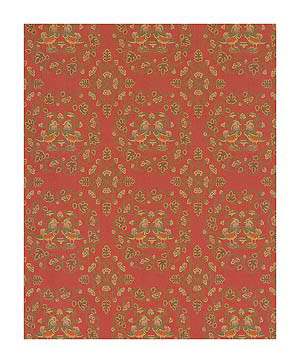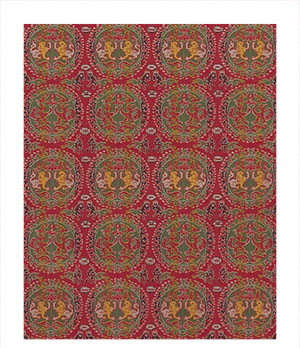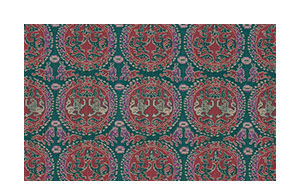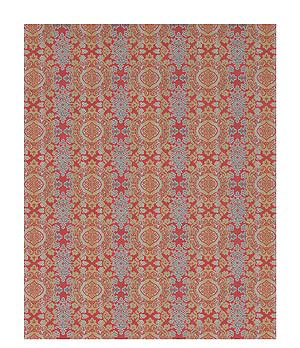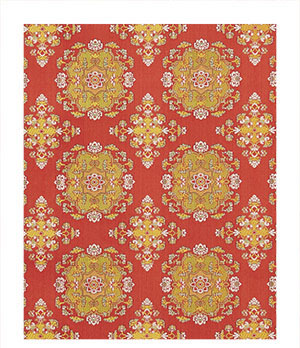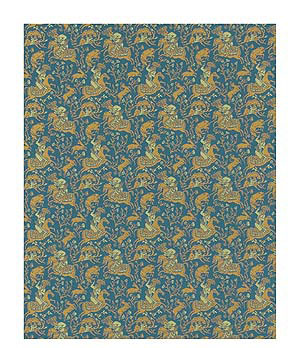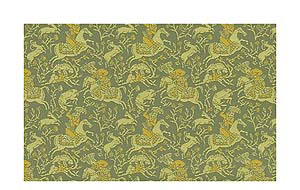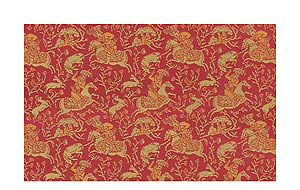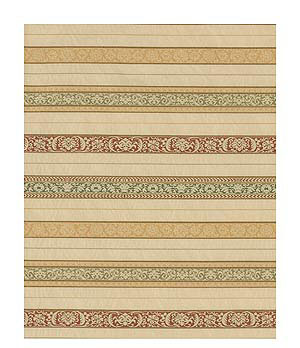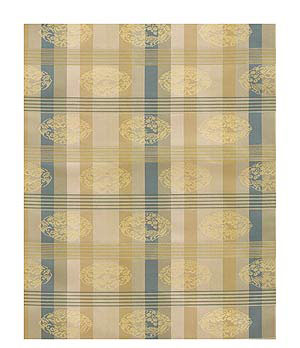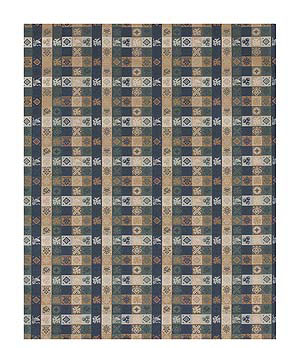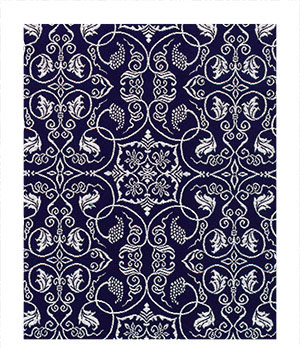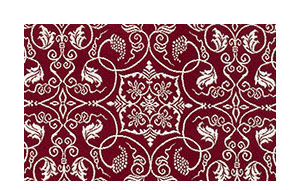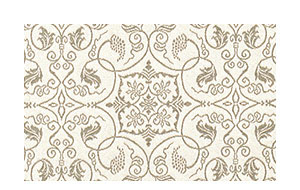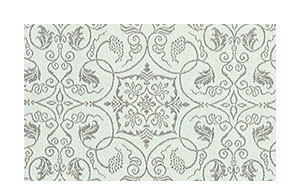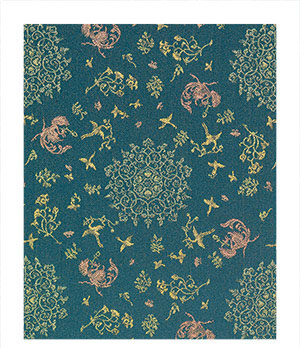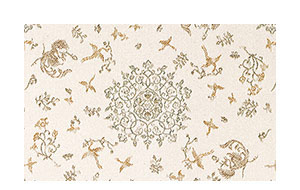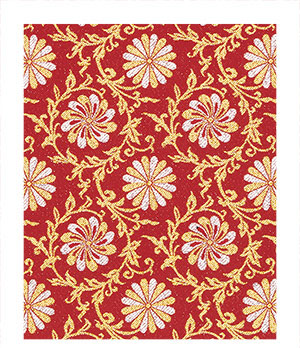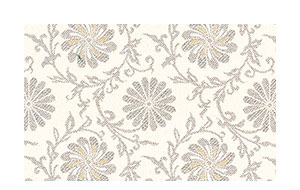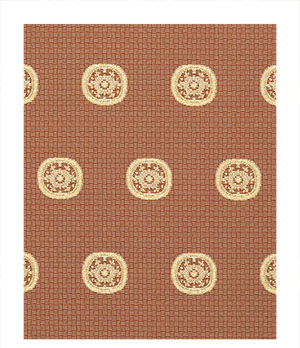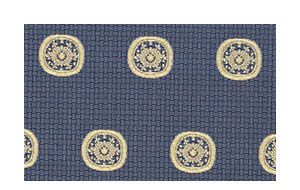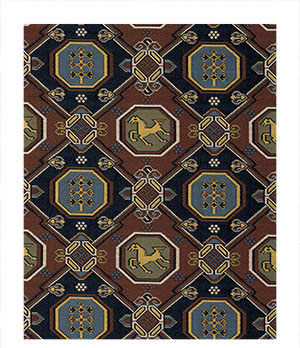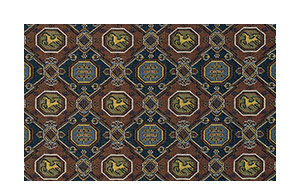裂地(きれじ) FABRIC
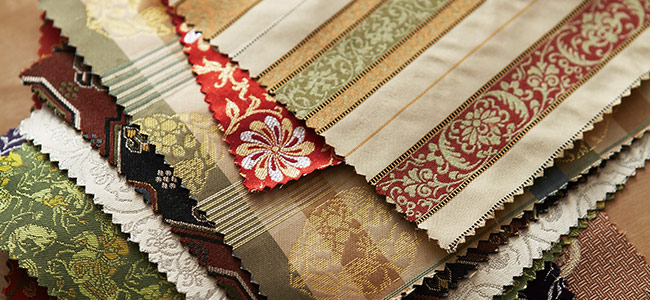
飛鳥・奈良時代(7~8世紀)より、伝世してきた染織遺品を「上代裂」とよんでいます。
「上代裂」には、法隆寺に伝わってきた法隆寺裂と、正倉院に収蔵されている正倉院裂(天平裂)とがあり、その技法は、多種多様にわたり、その質の高さは、見る者を古代へ夢さそわずにはおきません。
又、「名物裂」とは、鎌倉~江戸時代(13~19世紀)、茶道に親しむ人が愛用した裂地で、名物茶入を入れる仕覆(袋)や、書画の表装などに使ったのが名物裂の名の由来であるといわれています。これらの希少性高い織物――伝統の「古代美」をいま新たな感性と技術をもって味わい深くよみがえらせました。
赤地花文錦
"Nishiki, With Floral Patterns On A Red Ground"
DAF-129(R)
●絹100%●幅:約120cm
価格:24,500円/ m ※表示価格は消費税を含みません。
中国で、唐花文が最も爛熟し完成したのは盛唐期です。この錦の文様は唐花文の前様形式で、隋・初唐期のものと考えられ、のちに発達して唐花の主文となる六弁花文と副文の菱形花文とが、同じ大きさで存在しています。赤地に白・黄・水色の六弁花の縦縞部と,赤地に白・黄・緑の菱形花文の縦縞部とが交互に繰り返され、四色一経の経錦です。
The kara-hana pattern was developed to its most mature and complete from in China during the mid-T'ang era. The pattern of the original work, which is thought to date back to the Sui or early T'ang era, has the characteristic of a style earlier than this most highly developed style. The pattern shows six-petaled and lozenge-shaped flowers of the same size; in a pattern of the later style, the former flowers would be shown as the main motif, the latter flowers serving as subsidiary motif. Vertical patterns comprising white, yellow and light blue six-petaled flowers on a red ground alternate with others comprising white, yellow and green lozenge-shaped flowers on a red ground. Four differently colored yarns are used as warp.
天平鴛鴦唐草文錦
"Nishiki in the Tenpyo Period,with Tendril Roundels Enclosing Mandarin Ducks"
DAF-121(R)
●絹100%●幅:約120cm
価格:26,000円/ m ※表示価格は消費税を含みません。
「鴛鴦唐草文は、中国・六朝時代の意匠にしばしば見られるもので、鴛鴦は昔より夫婦相愛と和合を象徴しております。 我が国では、正倉院宝物の中に多種多様な形で鴛鴦文が見られ、中でもこの錦に見る鴛鴦は華麗でしかも格調の高さが注目されるものです。
The pattern showing tendril roundels enclosing mandarin ducks often appears in cloths produced in China during the "Six Dynasty" era. Since ancient times, mandarin ducks have been the symbol of love and harmony between husband and wife.
The mandarin duck pattern is used in various forms for treasures housed in the Shoso-in Repository in Japan. Among these treasures, this nishiki is noteworthy due to the gorgeousness and nobleness of its pattern.
円紋白虎朱雀文錦
"Nishiki, With Roundels Enclosing Byakko And Shuzaku"
DAF-130(R) DAF-131(DB)
●絹100%●幅:約120cm
価格:24,500円/ m ※表示価格は消費税を含みません。
この錦は円紋の中に古代中国の思想による四神(青龍・白虎・朱雀・玄武)の内、白虎(西)と朱雀(南)を織り出しています。
原本は法隆寺に収められており、中国3~4世紀の織物の技術を伝えるものと考えらえています。仏教と、仏教が中国に入る以前の中国固有の思想が重なり合って、きわめて複雑な文化の様相をしめした時代が、この錦の文様にもよく表れています。
※青龍…東方に配する神。 朱雀…南方に配する神。
白虎…西方に配する神。 玄武…北方に配する神。
The pattern of this nishiki shows roundels enclosing Byakko and Shuzaku, two of the four gods believed by ancient Chinese people.
The original nishiki is stored in Horyuji Temple. This cloth is thought to be an example of textiles manufactured in China during the 3rd to 4th century. The pattern of this nishiki testifies to the highly complex development of culture in China at that time, when Buddhism was mingling with indigenous beliefs.
天平装鏡宝相華文錦
"Nishiki, With Hosoge Flower Patterns Derived From A Mirror Of The Tenpyo Period"
DAF-128(R)
●絹100%●幅:約120cm
価格:24,500円/ m ※表示価格は消費税を含みません。
正倉院に秘蔵される鏡類は、その背面に種々の文様を表しています。例えば鋳出しの文様、あるいは金銀平脱、螺鈿、七宝等の装飾を施したものなど実に豊富な意匠をしめます。
ここではその鏡背の精巧な文様を選んで錦に織り上げました。唐時代の美意識をしめす左右対称の構成がきわめて厳格な感じを与え、さらに洗練された端正な趣をしめします。この宝相華は空想上の花ですが、意匠のあらゆるところに取り上げられて、人々の寿福を願う心を表します。このように、天平文化はまさに華麗な唐文化の影響を受けて国際色豊かに花開きました。その成果は正倉院に伝えられる宝物類に窺えます。
The backs of mirrors stored in the Shoso-in Repository are decorated with various patterns. These patterns were formed with a great variety of techniques, such as molding, heidatsu-lacquering, and inlaying with shells, gold, silver, or jewels.
This nishiki has an intricate pattern derived from one of the mirror backs. The symmetrical composition of the pattern, characteristic of esthetics in the T'ang age, gives an impression of utmost rigor. As a whole, the pattern has the charm of refined classicism. Imaginary hosoge flowers appear everywhere in the pattern, symbolizing hopes for happiness and longevity.
As witnessed by this nishiki, the Tenpyo period was a golden age of Japanese culture characterized by internationalism. The magnificent culture of the T'ang dynasty was the key influence on the flourishing Tenpyo culture. Treasures housed in the Shoso-in Repository are examples of the high cultural achievements in Japan during this period.
天平八稜華文錦
"NISHIKI(JAPANESE BROCADE)IN THE TENPYO PERIOD, WITH EIGHT-POINTED FLORAL PATTERNS"
DAF-120(R)
●絹100%●幅:約120cm
価格:26,000円/ m ※表示価格は消費税を含みません。
この錦の文様は、8 世紀半ばの天平時代、東大寺大仏開眼会に際し演じられた舞楽に使用された装束の文様とされています。
この文様の主文は、中央に小梅花をめぐらす複合八弁の開花蓮花をおき、その周囲に葉文をめぐらし、外周には花文のなかに蓮花を配した八箇の刳り形花文を連ねたものです。刳り形の間を小五弁花と掌状の菊葉形で埋めている点が珍しく、副文は4
箇の開花の間に蓮花をあしらい、中央に四弁花をおいた菱形花文とで構成され、全体に唐文化の華やかさをしのばせる意匠であります。
It is said that the pattern of this nishiki cloth is derived from the pattern of costumes worn by dancers, who danced in celebration of the completion of the gigantic image of Buddha in Todaiji Temple during the Tenpyo period (mid-8th century).
Situated at the center of the main motif of this pattern is a two-tiered eight-petalled lotus flower surrounded by small ume(Japanese apricot) flowers, and further encircled by a leaf pattern.
Eight foliated flower patterns, each containing a lotus flower, are placed along the circumference of the main motif.
A special feature of this motif is the introduction of small five-petalled flowers and palm-like chrysanthemum leaves filling the foliage.
The subsidiary motif is a lozenge-shaped flower pattern, composed of four flowers, interspersed with lotus flowers, and a four-petalled flower at the center. As a whole, this nishiki pattern is reminiscent of the magnificent culture of the T'ang Dynasty in China.
ペルシャ狩猟文錦
"Persian Brocade, With Hunting Motif"
DAF-133(DB) DAF-134(G) DAF-135(R)
●絹100%●幅:約120cm
価格:23,500円/ m ※表示価格は消費税を含みません。
狩猟の場面を意匠に取り上げるのは、はるか古代に源流があり、世界各地でしかも各時代特有の表現を示しました。
これはイラン、サファヴイ朝(1502-1736)の宮廷織物の中に見出したいわゆる「ペルシャ錦」によるものであります。
技法は錦地という組織に緯糸で文様を表した緯錦で、ここでは特に異国情緒あふれる色彩を駆使し、ペルシャの王宮の華麗さを再現しました。
Since ancient times, the hunting motif has been used for textile patterns in various parts of the world. Such patterns are characteristic of the taste which prevailed in a certain region during a certain period.
This brocade is modeled after a Persian brocade used at the court of the Safawid Dynasty (1502-1736) in Iran.
The patterns of this brocade are formed with weft on a ground. Exotic colors hint at the magnificence of the Persian palace.
花唐草段モール
"Laced Textile, With Patterns Of Rowed Floral Vine Scrolls"
DAF-143(BE)
●絹100%(金糸使用)●幅:約150cm
価格:45,000円/ m ※表示価格は消費税を含みません。
インドのムガール最盛期である17世紀後半から18世紀末に製作されたもので、淡黄地に色や文様を異にした段を等間隔に配し、銀モール糸を中心として文様を織り出しています。地の平織部分に縮みができて、文様の部分との間に裂の厚みの違いをしめす意匠に注目されます。
文様は精巧に織り出され流動的な唐草文と静的な唐草文に対比に工夫があり、ペルシャ風の趣がまた見所といえます。
This textile was manufactured in India during a period from the latter half of the 17th century to the end of the 18th century, when the Mogul Empire was at the height of its prosperity. The pattern of the textile is formed on a light yellow ground, mainly with a silver chenille yarn.
Strips with different colors and patterns are laid on the ground at the same interval. It is noteworthy that the plain-weave portion of the textile is wrinkled, showing the difference in thickness between this portion and the patterned portion.
江戸和久田金襴
"Edo-Wakuta Kinran"
DAF-144(BE)
●絹100%(金糸使用)●幅:約70cm
価格:18,400円/ m ※表示価格は消費税を含みません。
江戸和久田金襴は、江戸時代初期、江戸在住の織工・和久田が愛用したところからこの名で呼ばれています。
華やかな八色の縦縞に十筋の横細段を色替わりに交互に織り込み、段の間に花や鳥・鹿をおさめた木こうを表しています。
現状は渋く深味ある趣が魅力になっていますが、中国から船載された当時は縞の各色が冴え、目をあざむく鮮やかな美しさが人々を感動させたのです。
The edo-wakuta kinran is so named because Wakuta, a weaver who lived in Edo (now Tokyo) in the early Edo era, possessed and cherished this brocade.
The patterns on the kinran show eight gorgeously and differently colored vertical stripes, crossing 10 thin strips also different in color. Flowers, birds and deer appear between the strips. This type of pattern is called a mokko pattern.
Presently, the charm of the kinran lies in its deep and somber colors.
When it was imported from China, however, the brocade impressed people with the vivid and bright colors of its stripes.
石畳緞子
"Ishidatami(Tartan Check)Damask"
DAF-148(B)
●絹100%●幅:約120cm
価格:22,500円/ m ※表示価格は消費税を含みません。
小堀遠州の好んだ名物裂の中で最も著名なもので、遠州緞子の名で知られています。
白地と縹地で大石畳文を織り出し、白の唐花文と縹地の輪違い七宝文を織っています。
花色に近い薄い縹の地合いは「清」と「寂」そして「知性」を思わせ、七宝は吉祥を表し、牡丹花は富貴の象徴とされており、瀟洒な寂びの世界を醸し出しています。
The original work is the most famous among the meibutsu-gire cherished by Enshu Kobori (renowned master of chanoyu during the early Edo era). Accordingly, the work is known as the "Enshu damask."
An ishidatami (tartan check) pattern is formed with white and light blue grounds. Kara-hana floral patterns appear on the white grounds, and wachigai-shichiho patterns with intersecting circles, on the light blue.
The light blue ground of the damask is symbolic of cleanness, tranquility and intellect. Shichiho ("seven treasures") are the emblem of good luck, peony flowers that of wealth. The pattern's fascination lies in its serene tastefulness.
天平葡萄唐草文錦
"NISHIKI IN THE TENPYO PERIOD, WITH PATTERNS OF GRAPEVINE SCROLLS"
DAF-122(DV) DAF-123(R) DAF-124(I) DAF-125(LBG)
●絹100%●幅:約120cm
価格:26,500円/ m ※表示価格は消費税を含みません。
シルクロードを通って古墳時代後期から飛鳥時代(570 年頃〜 600 年代)にかけて大陸から植物文様が伝来し、奈良時代に華やかに開花しました。
古代の人々の農耕的信仰を反映し、特に葡萄唐草文様は蔓が次々と伸びるところに生命の終末のない喜びを思いたくさんの実のなるところに豊饒の願いを込めたものと考えられています。正倉院宝庫に数多く伝えられている葡萄唐草文様の内で最も優美さを表現しているものです。
Patterns modeled after plants were introduced from the Eurasian Continent into Japan through the Silk Road, during the period from the later Tumulus era to the Asuka era (ca.570-ca.700).
These patterns were colorfully developed in the Nara era (710-784).
A reflection of the belief of ancient people closely related to agriculture, the grapevine scroll pattern, representing the lush growth of vines, expresses the joy of endless life. As well, abundant fruits shown in the pattern are suggestive of hopes for a rich harvest.
Because of its elegance, the pattern of this nishiki stands out from various other grapevine scroll patterns used for treasures in the Shoso-in Repository.
天平金銀平脱背八角華文錦
"TEXTILE WITH OCTAGONAL FLOWER PATTERNS, MODELED AFTER HEIDATSU-LACQUERED MIRROR OF THE TENPYO PERIOD;
DAF-126(DB) DAF-127(BE)
●絹100%●幅:約135cm
価格:28,000円/ m ※表示価格は消費税を含みません。
天平勝宝8 年(756 年)6 月21 日、光明皇太后が東大寺大仏に献納した宝物類のうち、正倉院に伝えられる古鏡の意匠を題材としています。
鏡背の全面を飾る意匠は、六花形とパルメット文を組み合わせ、そのまわりに宝相華唐草を配し、五稜形唐花文を形づくっています。
外周には鳳凰と宝相華を交互に各4ヶ配して、その間に雁、小鳥、蝶、花弁、飛雲を散らし、唐文化の影響をしめしつつ、きわめて繊細な趣に注目されます。
The pattern of this textile is derived from that on the back of an ancient mirror stored in the Shoso-in Repository. This mirror is one of the treasures which Empress Dowager Komyo dedicated to the image of Buddha in Todaiji Temple on June 21,756.
The entire surface of the mirror back is decorated with patterns composed of six-flower and palmette patterns, surrounded by hosoge vine scrolls. As a whole, the patterns are designed as five-pointed kara-hana patterns (floral patterns which came into fashion in China during the T'ang era).
Four ho-o birds alternate with four hosoge flowers along the periphery, interspersed with wild geese, small birds, butterflies, flower petals and clouds. While influenced by the culture of the T'ang Dynasty, the patterns stand out due to their distinctive delicacy.
菊唐草文錦
"NISHIKI, WITH PATTERNS OF CHRYSANTHEMUM VINE SCROLLS"
DAF-136(R) DAF-137(I)
●絹100%●幅:約145cm
価格:36,000円/ m ※表示価格は消費税を含みません。
中国17 世紀中期の織物と考えられている裂によるものです。赤地に金モール糸を通し、銀モール糸で菊唐草文を全体に織り表しておりきわめて豪華な雰囲気にあふれています。
織裏面に金モール糸が織幅いっぱいに通る織技法によって、表面の赤地の部分に裏面の金モール糸が透けて見え、光の反射によって複雑微妙な印象を与える織物となっています。
This nishiki is modeled after a textile thought to have been manufactured in China in the mid-17th century.
The patterns of chrysanthemum vine scrolls are formed with a silver chenille yarn, over the entire surface of a red ground covered with a gold chenille yarn. The brocade is characterized by its extreme richness.
The back of the nishiki is covered with the gold chenille yarn to its full width, so that the yarn can be seen through the red ground. This technique helps create a complex and delicate play of light and color.
糸屋輪宝
"ITOYA-RINPO"
DAF-141(BR) DAF-142(DB)
●絹100%●幅:約120cm
価格:25,500円/ m ※表示価格は消費税を含みません。
利休門人、糸屋宗有の愛蔵した裂地と伝えられるもので、算崩し地に輪宝を織り出した風通織による品で、仏教が各地に及ぶ吉祥をも表しており、縁起のよい文様として広く愛好されています。
輪宝とは、金剛の輪宝を意味する仏教用語で理想の国王とされる輪廻聖王の所持する七宝の1 つとされています。そして輪宝は全て思い通りに事が成就し、長寿等の徳を与える力を持ったものとされています。
It is said that this textile was once owned and cherished by Soyu Itoya, a follower of Rikyu (renowned master of chanoyu [tea cere- mony]in the 16th century).
The textile, with a layered texture called futsu-ori, has a pattern of rinpo rings, formed on a ground with a basic sankuzushi striped pattern.
The rinpo pattern, symbolizing the propagation of Buddhism in every part of the world, has been popular with Japanese people for its auspicious character.
Rinpo is supposed to have the magic power to fulfill people's wishes, and bless them with longevity and other benefits.
有栖川錦馬手
"ARISUGAWA NISHIKI WITH HORSE PATTERNS"
(大柄)DAF-146(BR) (小柄)DAF-147(BR)
●絹100%●幅:約120cm
価格:30,000円/ m ※表示価格は消費税を含みません。
八角形と正方形を互いの目に連続させた幾何学的文様を基本としており、原本の経と地緯は濃い蘇芳で、裂面の全体を覆って文様を表し、絵緯は白、濃紺、水浅葱、萌葱、黄、蘇芳の6 色であります。
松皮菱をつないだような文様の構成は、西アジアのトルキスタンのカーペットのデザインを思わせるようなところがあり、中国のデザインとが混合した、大変特色のある意匠と織技によって製織されています。名称の由来は元、有栖川宮に所蔵されていたことによるといわれています。
It is said that this nishiki was manufactured in Persia in the 16th or 17th century, and brought to Japan by a Dutch ship in the early Edo era. Basically, the patterns on this nishiki are abstract and geometric, composed of octagons alternating with squares. The warp and weft of the original work are dull purplish red, forming basic patterns covering the entire surface of the brocade. White, vivid blue, light blue green, strong yellow green, yellow and dull purplish red wefts are used to form special patterns
.The patterns on the nishiki, modeled after the pattern on the bark of a pine tree, are reminiscent of the design of carpets manufactured in Turkistan in western Asia. A highly original feature of this brocade, noteworthy from the standpoints of both design and technique, is the Chinese flavor in its pattern. It is said that this nishiki is named after Arisugawa-no-miya, an Imperial Prince who once owned the brocade.
